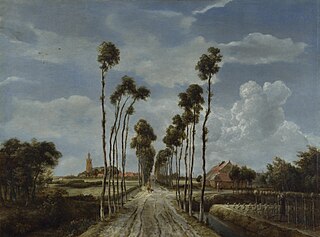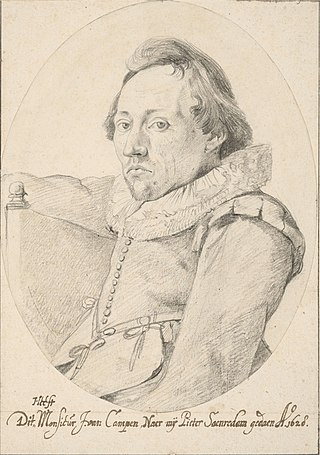
Gerbrand van den Eeckhout was a Dutch Golden Age painter and a favourite student of Rembrandt. He was also an etcher, an amateur poet, a collector and an adviser on art.

Willem van de Velde the Younger was a Dutch marine painter, the son of Willem van de Velde the Elder, who also specialised in maritime art. His brother, Adriaen van de Velde, was a landscape painter.

Meindert Lubbertszoon Hobbema was a Dutch Golden Age painter of landscapes, specializing in views of woodland, although his most famous painting, The Avenue at Middelharnis, shows a different type of scene.

Jacob Isaackszoon van Ruisdael was a Dutch painter, draughtsman, and etcher. He is generally considered the pre-eminent landscape painter of the Dutch Golden Age, a period of great wealth and cultural achievement when Dutch painting became highly popular.

Abraham Bloemaert was a Dutch painter and printmaker who used etching and engraving. He initially worked in the style of the "Haarlem Mannerists", but by the beginning of the 17th-century altered his style in line with the new Baroque style that was then developing. He mostly painted history subjects and some landscapes. He was an important teacher, who trained most of the Utrecht Caravaggisti.

The Hague School is a group of artists who lived and worked in The Hague between 1860 and 1890. Their work was heavily influenced by the realist painters of the French Barbizon school. The painters of the Hague school generally made use of relatively somber colors, which is why the Hague School is sometimes called the Gray School.

Pieter Jansz. Saenredam was a painter of the Dutch Golden Age, known for his distinctive paintings of whitewashed church interiors such as Interior of St Bavo's Church in Haarlem (1636) and Interior of the Sint-Odulphuskerk in Assendelft.

Jacob Cats was a Dutch poet, humorist, jurist and politician. He is most famous for his emblem books.

Willem Schellinks was a Dutch painter, draughtsman and etcher of landscapes and marine scenes and also a poet. Willem Schellinks was one of the most widely traveled Dutch artists of his time. He traveled along the Loire and the Seine in 1646, and between 1661 and 1665 he visited England, France, Italy, Malta, Germany and Switzerland, keeping a record of his travels in multiple landscapes and scenic views as well as a journal. Alternative spellings, Schellinger and Schellinx.

Jan de Beijer, also given as Jan de Beyer, was a Dutch draughtsman and painter known for this drawings of towns and buildings in the present-day countries of the Netherlands, Belgium and Germany. In total, he produced some 1500 drawings, over 600 of which were reproduced as engravings by other artists.
Richard Brakenburgh or Brakenburg, was a Dutch Golden Age painter.

Mattheus Ignatius van Bree was a Belgian painter. He was one of the founders of the historical school of painting in Belgium and played an important role as a teacher in the development of 19th-century Belgian art.

Michiel Carree or Carré was a Dutch Golden Age painter.
Antonina Houbraken was an 18th-century Dutch draughtswoman who is known for her many topographical drawings of Dutch sites. She also drew landscapes. She is recorded as a skilled portraitist.

Louis Bernard Coclers was a Southern Netherlandish portrait painter and engraver who worked mainly in Liège, Maastricht, Leiden and Amsterdam.

Adriaan de Lelie was a Dutch painter.

Louis Fabricius Dubourg or Louis Fabritius du Bourg was an historical and academic painter of arcadian landscapes, and an engraver.

Johannes de Bosch (1713–1785) was a Dutch painter, engraver and draughtsman. He was born in Amsterdam, the son of the apothecary Jeroen de Bosch who owned a significant collection of paintings and drawings, so he was surrounded and influenced by fine art from an early age.

Pieter Stevensz. van Gunst, also known as Pieter Stevens van Gunst or Petrus Stephani, was a Dutch draughtsman, copperplate engraver and printmaker active in Amsterdam, London (1704), and the Dutch town of Nederhorst (1730-1731).

Johannes Hermanus Koekkoek was a Dutch painter and draughtsman.



















